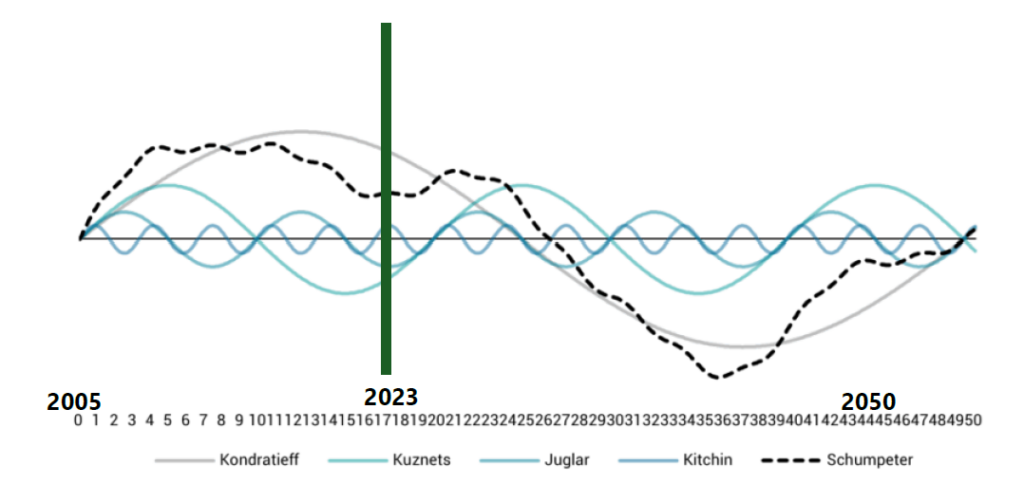By Guido Willemsen
We are heading for difficult times, while entering the macro-economic downfall, which could result in a dramatic chaotic situation. According to the Schumpeter Cycle, which is an integrated model to visualize the economic cycles (Schumpeter, 2017), we will enter an era of economic adversity. But how do we prepare ourself for this recession as a company? In an article of the Sloan Management Review, it is clearly pointed out that leaders should be prepared for the next recession. The worst times for the economy as a whole can be the best of times for individual companies to improve their fortunes (Sull & Sull, 2022). That means that your organization should be in good shape in time. But how do you achieve this? According to the Sloan article, one of the key success factors is local agility. But what does that mean?
Despite many research, (social) economic models are still in its infacy and there is a lot of uncertainty in economic predictions. And in that case, we learned that simple models just give a pretty appriopriate result, irrespective of all interesting development in complexity economics (Arthur, 2019).

Different economic cycles like the Kondratieff (50 years), Kuznets ( 20 years), Juglar (10 years) and Kitchin cycle (4 years) are coming together in the Schumpeter Cycle. According to the Schumpeter Cycle, we are heading for a serious economic recession in a few years. But how do we prepare to become an industry leader in this difficult times? A fine-grained and balanced business archicture and a sound strategy becomes critical to enter or stay in the vanguard of business.
When you prepare your business for the worst, you can better do this in times of prosperity than in economic decline. And you want to prevent a downturn while the situation still offers many opportunities for growth.
A balanced business architecture is critical to survive difficult times. There are many viewpoints and abstraction levels to model, analyze and build a strategic grid for an organization. In general, the business architecture contains a certain set of topics: Strategy, Capabilities, Value Streams, Knowledge Base and Organization. These building blocks can be recognized in most generic architecture frameworks like Zachman, OMG, CIMOSA, Archimate and TOGAF or industry-specifc models like eTOM, PCF and SCOR (Kitsios & Kamariotou, 2019).
Despite the many frameworks, methodologies and modeling techniques, a business architecture is still custom made, based on the objectives, strategy, capabilities and context of the organization. But when creating this architecture, a few important rules of thumb should be applied:
1. Make your goals explicit and balanced
2. Translate your goals in Critical Success factors (CSF), which will be the main principles for design
3. Select the dominant CSF to prioritize design trade-offs
4. Embed the CSF in ALL the building blocks of the architecture
a. Capabilities
b. Process
c. Information
d. Organization
e. Governance
5. Solve dilemma’s for each architecture design
As mentioned before, according to Schumpeter, we will soon enter a period of economic downturn. And one of the characteristics during this situation of turnaround is the phenomena of Creative Destruction (Schumpeter, 2017), a ground-breaking, disruptive situation where former rules do not longer apply. This implies that the organization ha to become resilient by smart strategy and an adaptive business architecture. This can can be achieved by a loosely coupled architecture and processes based on late binding.
An organization consists of a myriad of activities, all with their own purpose, restrictions and requirements. These are channeled by organization and systems design, hopefully directed by strategic decisions. However, these interdependencies makes the organization rigid with a natural tendency to resists change. In the groundbreaking work of Geoffrey West on scaling, he concludes that a firm has to split itself when a critical mass has been achieved. Only in that way, the company is able to achieve infinite growth, which is most relevant to head up with market dynamics (West, 2018). A loosely coupled architecture should overcome this problem. And so it will become a main driver to advertise local agility.
Characteristics of a loosely couples architecture are:
1. Agnostic to outside concerns
2. Low dependencies between each other
3. Clear interface for communication
4. Scale-free
5. Single purpose and single responsibility
6. Allow small and frequent changes
7. Fast recovery for failure
An organization based on a loosely coupled business architecture can grow or shrink much more easily than machine bureaucracies (Baum & Rowley, 2017). A typical
organization like this is based on self-organized teams who can act on their own, but share common principles like culture and share knowledge intensively.
As a famous roman empire once said “Divide and Conquer”.
In the Sloan article “Preparing Your Company for the Next Recession” by Donald and Charles Sull, a clear strategy is described to focus on the critical success factors before a downturn sets in.
This strategy is based on three pillars: resilience, portfolio agility and local agility. (Organizational) Resilience can be achieved by creating a war chest when times become worse. The most important measures will be access to cash to overcome revenue declines. This can be internalized by savings or externalized by building trust with investors.
Portfolio agility is the ability to spread risk over multiple products or markets. The risk of becoming fully dependent on a small set of products or to become locked in on a specific market could become fatal in times of recession. Spreading the risk over a-cyclic markets and demands for products will increase the chance of survival.
The need for a smart architecture becomes evident when local agility is pursued. Sull & Sull explain that local agility requires decentralized decision-making in a clear strategic context. And this is exactly what is achieved with a loosely coupled architecture. Each domain acts on its own, within clear boundaries and with clear principles. The Critical Success Factors mentioned earlier will be the guidelines for decisions and prevent organizational drift. At the same time, quick response to changes in the environment is enabled by local actions. This is where the agility comes in. On the other hand, the Board should be able to apply top-down decisions quickly. In a loosely coupled organization, removal of business units or absorbing competitors can be effectuated almost instantly.
Due to the economic forecast, the need for a well-thought-out architecture has become critical. A balanced, agile organization structure prepares companies for the worst to come. A loosely coupled architecture can do the job. Become resilient and agile; prevent chaos!
Read the interesting article in Sloan Management Review by Donald Sull and Charles Sull: https://sloanreview.mit.edu/article/preparing-your-company-for-the-next-recession/
